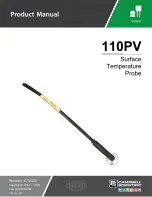
535-PROF User's Manual
Chapter 7
79
Applications
A. PROFILE CONTROL
The 535-PROF controller is capable of storing 20 separate recipes. Each recipe
can consist of up to 12 ramps and 12 dwells. Individual recipes may be continu-
ously run or be repeated up to 99 times. Recipes may be linked together to form
longer, more complex recipes. Some profile control terms are:
Ramp
A rise or fall of the setpoint in a given segment. Ramps may be defined by the
time it will take for the setpoint to be achieved or the rate of rise or fall necessary
for the target (soak) setpoint to be achieved.
Dwell or Soak
The designated period of time in which the setpoint does not change after the
ramp has been completed.
Guaranteed Soak
Guaranteed soak insures that the soak setpoint has been achieved before
the soak segment starts.
Example: Ramp 1 is programmed for 2 hours. The Soak setpoint is 400° and
the soak time is set for 4 hours. If 400° can not be achieved in the 2 hour ramp
time, the timing of the soak will not start until the setpoint has been reached.
To use this feature,two parameters must be defined. The first one,
GUAR.SOAK
, defines whether guaranteed soak is used and how it is used. It is
located in the
REC.CONF.
menu. The second parameter,
SOAK HYST.
, is
located in the
RECIPE #
menu. It defines the absolute value of the maximum
allowable deviation from setpoint when a soak segment starts. If the deviation
exceeds this value, guaranteed soak will stop the clock until the deviation is less
than the soak hysteresis. Then the soak segment will begin. In addition, if the
deviation exceeds the soak hysteresis value during the soak segment, the soak
timing will stop until the deviation is less than the soak hysteresis value.
Cycles
Recipes may be repeated up to 99 times before completion or being linked to
a different recipe. Recipes may also be set up to run continuously.
NOTE:
Controller capabilities depend
upon the specified hardware option.
CHAPTER 7
APPLICATIONS
The 535 controller provides a variety of user-programmable control features and
capabilities. The following topics are included in this chapter:
A. Profile Control ................................................. 79
B. Control Type ................................................... 85
C. Alarms ............................................................. 86
D. Duplex Control ................................................ 90
E. Slidewire Position Proportioning Control ..... 95
F. Velocity Position Proportioning Control ...... 96
G. Staged Outputs .............................................. 97
H. Retransmission .............................................. 97
I .
Digital Inputs .................................................. 98
J . Remote Setpoint ........................................... 100
K. Multiple Setpoints ........................................ 101
L. Multiple Sets of PID Values ........................ 101
M. Powerback .................................................... 102
N. Self Tune—POWERTUNE
®
.............................
103
O. Ramp-to-Setpoint ......................................... 109
P. Input Linearization ....................................... 109
Q. Load Line ....................................................... 111
R. Security ......................................................... 111
S. Reset Inhibition ............................................ 112
T. Process Variable Reading Correction ........ 112
U. Serial Communications ................................ 113
V. Cascade Control ........................................... 114
W. Ratio Control ................................................. 117
NOTE:
Self Tune and Adaptive Tune may be
used to optimize PID settings at
varous PV/LOAD points, but should
NOT be used while running a recipe.
Consult factory for further details.
















































